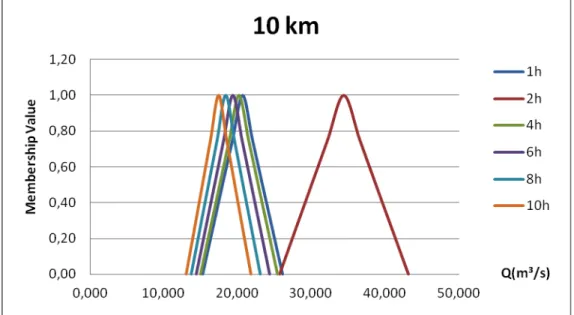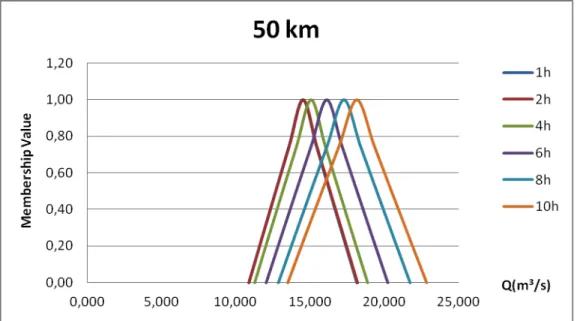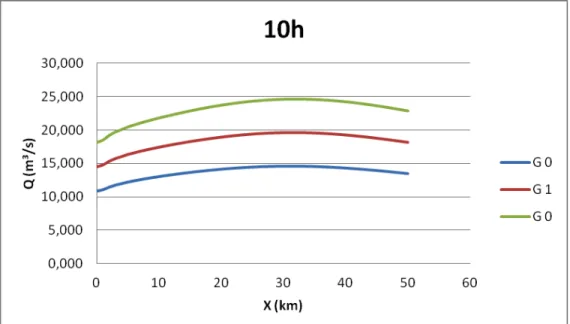The application of fuzzy set theory in the Saint Venant’s equations to
study the flood wave propagation in the Potengi river, Rio Grande do
Norte - Brazil, through the calculation of the flow as membership
functions
Sales, Raquel Jucá de Moraes1; Araújo, Juliana2 Alencar Firmo de; Santos, Silvia Helena3; Souza, Raimundo4 Oliveira de
Universidade Federal do Ceará e bolsista da CNPq, Ceará, Brazil
Abstract. A mathematical model based on the equations of hydrodynamics combined with the
fuzzy set theory was formulated, for the flood wave propagation in natural rivers. The model is able to evaluate the behavior of the control variables as membership functions. For the solution of the model governing partial differential equations, the Finite Difference Method was used, and for the solution of the resulting system of nonlinear algebraic equations, the Newton-Raphson Iteration Method was used. The results show that the use of Fuzzy Set Theory in the Hydrodynamic model could be an available alternative to determination of the uncertainty and to the Fuzzy Risk Analysis in the flood wave propagation.
Keywords: Fuzzy Set Theory; Hydrodynamic Model; Flood wave control. 1 Introduction
The increase of the urbanization in the cities, joined the planning lack, is provoking, consequently, different impacts in the regime of the water, such as: increase of the maximum flow and of the superficial drainage, reduction of the time of pick and increase of the frequency of the flood. In this context, there is the necessity to study forms of urban planning, so that these occupations could be structured and, consequently, be reduced the risk of inundations in used areas, mainly, for house.
To begin the study in the ways of urban planning, in the proximities of any body of water system, it is necessary to know the dynamics of the river. In other words, one tries to know as the river answers to an inundation, considering that the propagation of a flood wave, in the space and in the time, is a complex problem.
Usually, the mathematical models that describe the unsteady flow in open channels are composed by the momentum equations and of the continuity equation, developed by Saint Venant, that are partial differential equations, strongly no lineal, whose solution can be obtained using the model of the dynamic wave. In this study, the mathematical model to be used is based on Saint Venant's equations, and was solved for the finite differences
method. The resulting system of linear equations was solved by the iterative method of Newton-Raphson.
However, as this study concerns to an analysis of uncertainties, there is the necessity of a transformation in the Saint Venant’s equations in a fuzzy system of equations. That is
1 e-mail: raqueljuca@gmail.com 2 e-mail: judiaraujo@yahoo.com.br 3 e-mail: silviahlsantos@hotmail.com 4
done with introduction of the Fuzzy Set Theory, whose main advantage is not to need of great groups of data to reach their main objectives.
In such way, this research has, for objective, to develop the study of the propagation a flood wave, in Potengi River, Rio Grande do Norte,-Brazil, verifying the way it can be evaluate the present uncertainties in the mathematical models, and in the groups of used data. The study solves the equations of the model in the fuzzy form, calculating flow fields, along referred river, in a structure fuzzy, where the flows are presented as membership function.
2 Methodology
The basic equations, used for the mathematical modeling of the superficial flow, are obtained by the application of the law of conservations of the mass and momentum law in a control volume that represents the flow. In general, those equations are expressed in the differential form and, with the use of numeric methods resolution, the differential
equations can be solved Therefore, one has (Chow, 1988). Continuity Equation 0 A Q t x ∂ +∂ = ∂ ∂ (1) Momentum Equation
( )
/ ( ) 0 0 2 = + − ∂ ∂ + ∂ ∂ + ∂ ∂ f gAS gAS x y gA x A Q t Q (2)Where: Q is the flow (m3 / s); x is the longitudinal distance along the channel (m); t is the time (s); A is the area of traverse section of the river (m); y is the depth of the water in the channel (m); it is the steepness of bottom of the channel (m/m); is the energy grade line; and g is the acceleration of the gravity (m / s2).
Amein and Fang (1970) and Amein and Chu (1975) recommended to solve the system of algebraic equations, resulting from the numeric representation of Saint Venant's
equations for the finite differences method, through the application of the
Newton-Raphson Iterative Methods. The equation for the iterative process can be represented in the following form: ) ( -) x -)( (xk xk 1 k f xk J + = (3)
Where the system of linear equations involves the Jacobean that represents the matrix of the coefficients formed for the partial derivatives of f(x) in relation to A and Q, and it involves, also, the vector of the negative values of the residues in the equation (3). This system is solved for(xk+1-xk)=Δxk, and the improved estimate xk+1 value of the solution is determined being known about the value ofΔxk. The process is repeated until that (xk+1-xk) be smaller than right specified tolerance.
Fuzzy Aspect
The fuzzy theory and the logic fuzzy have become the base for the generation of powerful techniques for the solution of problems, with a vast applicability, especially in the control areas and socket of decision.
The force of the logic fuzzy comes of its ability in to infer conclusions and to generate answers based in information vague, ambiguous and incomplete and imprecise. In this aspect, the systems of base fuzzy have ability to ratiocinate in way similar to the one of the humans. Its behavior is represented in a very simple and natural way, taking to the
construction of comprehensible systems and of easy maintenance (Vieira, 2005). Part of this research is linked to the risk theory, where this risk is calculated using as base the fuzzy set theory. For such, it is necessary the represent the model in a fuzzy way. This is done through the transformation of the equations of the model and of their boundary conditions in fuzzy equations. In this case, instead of the solution to supply a control variable, it will supply a membership function for each control variable, in function of the time and of the space. Thus, the new equations change in (CHAGAS, 2005, 2010):
Continuity Equation: A Q 0 t x ∂ +∂ = ∂ ∂ (4) Momentum Equation
(
~ ~)
0 ~ ~ ~ ~ 1 ~ ~ 1 0 2 = − − ∂ ∂ + ⎟ ⎟ ⎠ ⎞ ⎜ ⎜ ⎝ ⎛ ∂ ∂ + ∂ ∂ f S S g x y g A Q x A t Q A (5)Where: A~t is the membership function for the traverse area of the river; Q~ is the membership function for the flow; ~yis the membership function for the depth; S~0 it is the membership function for the steepness of the bottom; and S~f is the membership function for the energy grade line.
Besides those formulations, it is had, still, to complete the model, the correspondents boundary and the initial conditions:
Resistance equation: 2 / 1 3 / 2 ~ ~ ~ ~ 1 ~ f S R A n Q = (6)
Where: R represents the Hydraulic radius and n the roughness coefficient.
Equally, in the solution process, the methodology described previously, concerning to the process of Newton-Raphson, it will have to be altered, considering in view the
peculiarities of the new model. Like this, the representation matrix equation can be transformed in the following way (Andrade, 2006, 2010):
Where: J~represents Jacobean in its fuzzy form; d~x represents the vector solution in its fuzzy form, and R~represents the residual fuzzy vector.
3 Results And Discussions
Starting from the results, obtained through the computational program, it was possible to do some analyses with respect of the behavior of the propagation of a flood wave, where the flow is calculated as membership function. The data of the Potengi river, used in the following simulations, are: length of the channel 50 km, temperature of the water 30ºC and width of the channel 37 m. The membership functions for the roughness coefficient and bed slope of the channel [0.0075; 0.01; 0.0125] and [0.00003; 0.00004; 0.00005] m/m, respectively. The simulations were accomplished for a more favorable situation, where a flow of 14.5 m3/s was considered. In these simulations, the width of the wave has pick flow three times larger than the flow in uniform regime. Already with relationship the time of base, was considered for this parameters a time of 2 hours. The effects of tides were not considered.
Figure 1 – Membership function of the flow 10 km of the origin, for different times.
The Figure 1 shows the membership functions of the flow, for different times the times. For the results, it is observed, in much defined way, the dynamics of the propagation of a flood wave. As they can be verified, the pertinence levels change for different times, in the considered section. For instance, for a time of 2 hours, the flow with larger
pertinence level, in 10 km, is, approximately, 35 m3/s, whose the membership value is close to 1. This means that, for this situation, this value is the most probable value that the flow can have, in the section of 10 km of the origin. Already, for the times of 10, the flow with larger membership value, approximately, of 18 m3/s. Another observation that can be done is that this methodology allows that it is made calculations, for different membership levels, that determine the fuzzy number, where the uncertainties can be studied. This is Fuzzy Theory essence, and its application in the calculation of the risk in engineering.
Figure 2 – Membership Functions of the flow 50 km of the origin, for different times.
The Figure 2 illustrates the membership function of the flow for a section to 50 km of the origin. In this case, for the results, the flow with larger membership value, for all of the times, is in the interval of the flow among 14 m3/s and19 m3/s. The base of the fuzzy numbers is in the approximate interval among 10 and 25 m3/s, which it represents an important element in the determination of the risk fuzzy. As it can be seen, the behavior of the membership functions is related with the passage of the wave in each section, showing, like this, that there is a direct relationship among the propagation of the wave, and
behavior of the present uncertainties in the membership functions. This fact is of fundamental importance in the analyses of flood risk, concerning with the fuzzy theory.
Figure 3 – Propagation of the wave for different membership value for a time of 2 hours.
The Figure 3 illustrates the propagation of the wave, in function of the distance, for a time of 2 hour, for different membership values. In agreement with this illustration, the different lines that define the membership degrees, they are very distant one of the other ones in the firsts sections of the channel, showing, therefore, that, for this time, the base of the of the fuzzy numbers, it is very large. This implicates to say that fuzzy number for the flow, to Potengi River, considering the used data, has a large base of possibilities, in the beginning of the propagation of the wave.
Figure 4 – Propagation of the wave for different membership degrees, after 10 hours.
Already the Figure 4, illustrates the propagation of the wave with it distances along the channel, for different membership values, in a time of 10 hours. Starting from the results one sees that, for this simulation, the pick of the wave is to 30 km from the origin. The illustration allows observing although there was a displacement of the lines with
membership values equal to zero. In other words, in the limited area for the lines inferior and superior of the Illustration 4, it is possible to find the base of the fuzzy number,
indicating the possible flows for the Potengi River, in agreement with the data used for this simulation. Still, in agreement with the illustration it is possible to see that, the closer of the central line of the illustration, bigger will be the membership value for the flow, reaching the value 1 on top of the line G1. This means that as close as of the defined area for the line G1, the bigger will be the possibility to find a value for the flow in the Potengi River.
Observing the Figure 5, the same previous result is verified, considering a time of 1, 2 and 10 hours. As it can be observed, the pick of the wave is in a section, approximately 30 km of the origin, considering the time of 10 hours, what shows that, in 10 hours, the pick of the wave moved a distance of 30 km, approximately. Another important observation is the that the results show the dynamic of the flood wave propagation, where the pick of wave appears in different section, for different time, showing that this dynamic plays a important game in the behavior of the risk functional.
Figure 5 – Propagation of the wave for highest membership value for different times.
4 Conclusions
After the accomplishment some simulations, with the aid of a computational program developed for this research, some results were obtained and analyzed. The model was applied in the Potengi River, where one looked for to analyze the possibilities to apply this type of methodology for the determination of fields of inundation risk in the passage of a flood wave in referred river. After the analysis of these results, some conclusions could be made.
The transformation of the classic hydrodynamic models in hydrodynamic fuzzy model has shown viable in the study of the uncertainties in unsteady flow in rivers subject to the propagation of a flood wave. This implicates to say that it is possible to determine, starting from this methodology, the risk of inundations for a certain close area of the margins of any river.
From the results, it can be said that the determination of the flow in each section of the river, as membership functions, allows evaluating the set of fuzzy numbers for different membership levels, what guarantees a real possibility for the evaluation and quantification of the present uncertainties in the flow process.
Finally, for the results it is verified that the membership functions of the flows move so much for the right as for the left, in agreement with the passage of the wave in each section of the channel, altering, like this, the behavior of the uncertainties and, in consequence, altering the behavior of the inundation risk for referred river.
Acknowledgements. Our thanks to CAPES and CNPq for the financial support through scholarship what
enabled the development of this research. References
Amein, M., Chu, H. L. (1975) Implicit numerical modeling of unsteady flows. Proceedings of the American Society of Civil Engineers, Journal of the Hydraulics Division, USA, 101(HY6), 1083-1117.
Andrade, C. F. (2006) Estudo de Planicies de Inundação através da Análise dos Parâmetros Hidráulicos do
Canal Principal e sua Influência na Avaliação do Risco Fuzzy de Enchentes, Tese (Doutorado em
Engenharia Civil) – Departamento de Engenharia Hidráulica e Ambienal, Universidade Federal do Ceará, Fortaleza, p. 212.
Andrade, C. F., Ueta, V., Chagas, P. F., Santos, S. H. (2010) Flood Risk Analysis of Cocó Urban River in Fortaleza, Brazil, Proceedings of Hydrology Days 2010, March 22-24, Fort Collins, Co., p. 128-134. Chagas, P.F. (2005) Perspectivas da aplicação da teoria Fuzzy para cálculo de risco em sistemas
hidrodinâmicos. Tese (Doutorado em Engenharia Civil) – Departamento de Engenharia Hidráulica e
Ambiental, Universidade Federal do Ceará, Fortaleza, p. 190.
Chagas, P.F., Santos, S. H., Andrade, C. F., Ueta, V. (2010) Application of Mathematical Modeling to Study Flood Wave Behavior in Natural Rivers as Function of Hydraulic and Hydrological Parameters of the Basin, Proceedings of Hydrology Days 2010, March 22-24, Fort Collins, Co., p. 114-120.
Chow, V. T. (1959) Open–channel hydraulics. McGraw–Hill, New York, N. Y., 680 pp.
Vieira, V. P. P. B. (2005) Análise de risco em recursos hídricos: fundamentos e aplicações. Porto Alegre: ABRH, 361 pp.



